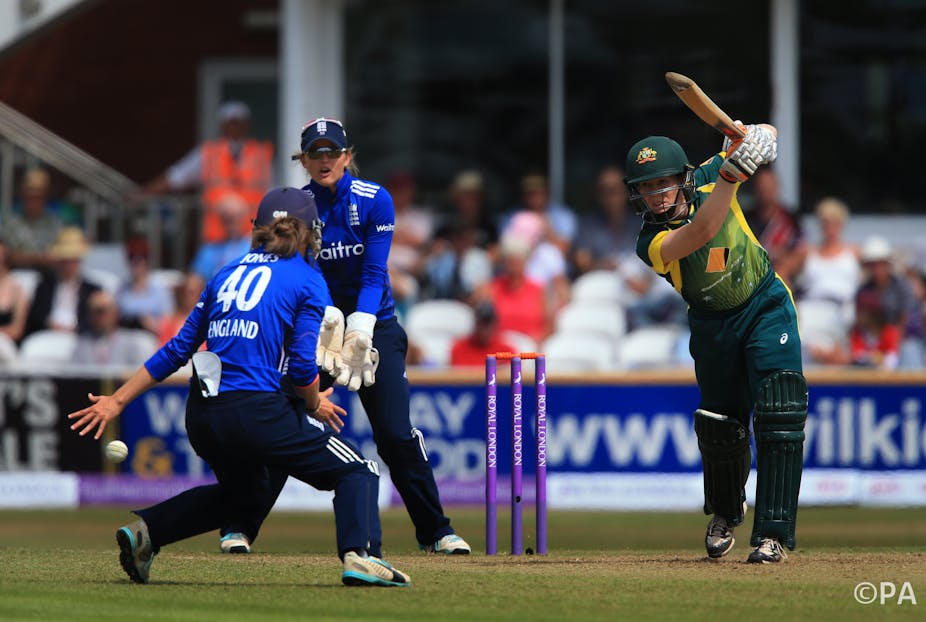There’s no doubt that it’s been an exciting year for women’s sport – the FIFA Women’s World Cup in Canada was very successful, with the highest attendance ever recorded. At Wimbledon this year female wheelchair athlete Jordanne Whiley became the first British player in history to win four grand slam doubles titles in one season, after winning the wheelchair doubles final with her playing partner Yui Kamiji.
Female presence and success in sport is also being showcased in cricket this year, a sporting space that was once exclusively for men. The Women’s Ashes series, the third ever played, is being contested by two fully paid women’s teams for the first time after the England women’s cricket team went professional last year. The matches will also be broadcast live for the first time – and England has handily won the first one day match.
Women’s cricket has received significant investment recently, which has led to the imminent introduction of the Women’s Cricket Super League in the UK and the Women’s Big Bash League in Australia.
Great strides
The increasing visibility of women’s sport in the media is increasing with a strong focus on the performance and achievements of female athletes. Marketing campaigns such as This Girl Can, which was introduced by Sport England to empower women to be active, are well connected to the modern realities of female participation in sport.
Indeed, the modern landscape of sport has distanced itself from the historical sporting world which was traditionally regarded as a male space. It was presumed that only men possess physical characteristics suited to sport. Women have therefore been excluded from participating in sport because of various social and medical assumptions held about their unsuitability to sporting activity. For example, in 1998 female boxer Jane Couch successfully won a legal ruling to be granted a boxing licence after the British Boxing Board of Control (BBBC) prohibited her from competing on the grounds of her sex. Justifications for this exclusion were largely underpinned by ideological assumptions about femininity, masculinity and biological performance.
Modern sport has undergone change which has been influenced by feminist social movements and a positive shift in the gender regime. The success and commercial expansion of women’s sport today has prompted an evaluation of how sporting divisions work. Recently it was announced that, for the first time, international women’s football teams will feature in the video game FIFA 2016. This is all part of a normalisation process, with the presence of women in sport becoming more common and accepted.
Regulate responsibly
Despite these developments, covert inequities in sport continue to affect women’s engagement and acceptance in sport. There remain clear disparities between women’s and men’s sports, often with little justification. This is evidenced by the imbalance between some male and female events in the Olympic programme.
In 2010 a group of female ski jumpers lost their sex discrimination case against the Vancouver Organising Committee for the 2010 Winter Games, where they argued that a female ski jumping event should be included in the games, just as it was for men. Despite the reluctance of the court to hold the committee accountable, continued public pressure resulted in the introduction of female ski jumping at the 2014 Sochi Winter Olympic Games.
So, as women’s sport embraces this exciting phase, it is critical that sports governing bodies regulate responsibly.
Sport is a realm held together by many of its own unique structures and frameworks. Soaked in longstanding values and belief systems, it possesses cultural exclusivity, which is a key part of sport’s essence. This sporting culture can have a negative effect on participation and access to sport, particularly for minorities.
Ahead of the Women’s World Cup, a group of female footballers brought legal action against the Canadian Soccer Association and FIFA, on the grounds that the decision to use synthetic pitches for the tournament constituted sex discrimination. Although the case was withdrawn, it highlighted the potential incompatibility of sport with the existing legal framework of equality legislation, in circumstances where there is no justification for differential treatment.
Out of the sporting context exists a range of international, regional and domestic discrimination laws that seek to protect individuals from derogatory treatment and promote principles of equality.
In order to build upon the success of women’s sport this year, there needs to be better regulation of both overt and covert discrimination on the field. Sports bodies should expose the misguided cultural assumptions that exclude women from sport by adopting reformative measures that will achieve equality. There is potential for the law to play a complementary role in the facilitation of this change, through varying levels of regulation from an internal audit of the structures and processes of sports bodies, to the establishment of an international anti-discrimination unit who would act as enforcers in the fight against discrimination in sport.
Where sport lacks awareness or seeks to deny that such practices exist, there is an argument for the law to intervene through the application of legal principles to promote good governance, or through public accountability under equality legislation. The continued acceleration of women in the sport industry is reliant upon better regulation of practices in the field. And if sports bodies don’t act responsibly, they should not be excluded from the law.

